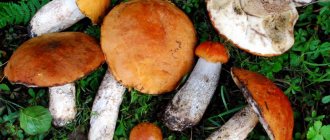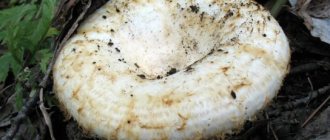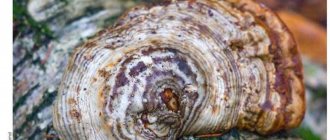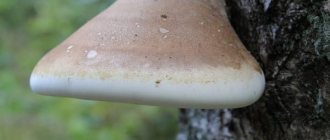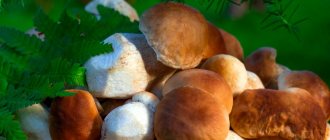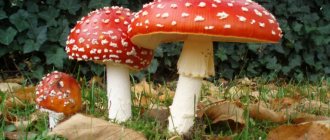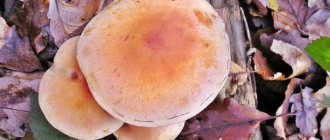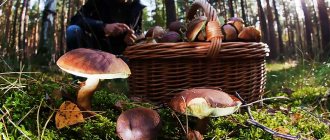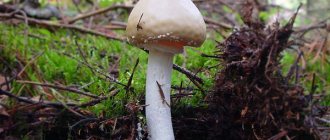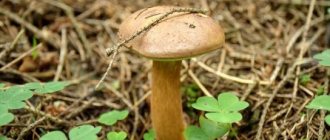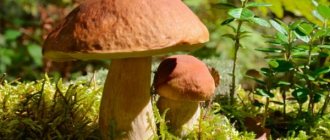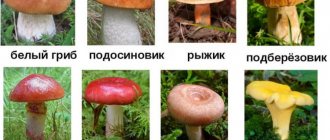Mushroom picking always turns into a gambling hunt. This is not only a fun, but also a useful activity. In just one mushroom foray you can recharge your batteries in the forest and provide your whole family with supplies for the winter. Traditionally, mushrooms with brown caps are trusted by lovers of quiet hunting. Let's consider some types of edible mushrooms and their poisonous counterparts, their places of growth and characteristics.
Features, places of growth and season of edible brown mushrooms
Among the brown mushrooms there are many edible ones. The following are edible: oyster mushrooms, oyster mushrooms, chanterelles, hedgehog mushrooms, sandpipers, obabok, champignons, saffron milk caps, poplar rows.
Porcini
Some individuals of this species grow up to half a meter.
They have a large velvet hat measuring up to 30 cm in diameter. The leg is powerful and strong, covered with a barely noticeable mesh. The elastic, hard, white flesh, when cut, does not lose the properties inherent to this type: it does not change in composition and does not darken, and does not release milk. Despite the fact that they grow almost everywhere, they are rarely encountered on the path of mushroom hunting lovers. The brown mushroom can be found in medium-aged (over 20 years old) spruce or mixed forests from the beginning of July to the end of September. Boletuses do not like wetlands. Choose dry, well-lit edges, next to lichens and mosses.
Reference! Porcini mushroom contains amino acids. Helps cleanse the walls of blood vessels from atherosclerotic plaques. Positively affects cell renewal.
Brown dubovik
Closest relative of boletus. Can reach a significant value. The largest representatives of this company have a velvety cap up to 20 cm in diameter and a wide oval stem with small specks. When damaged or pressed, the oak tree reacts by changing color. A blue mark forms at the pressure point.
Oak trees can be found in the forests of the Caucasus, Carpathians, northern regions and central Russia. These mushrooms love wooded hills, wet slopes, and prefer young oaks.
They begin to appear in forests in early summer. You can find them until late autumn, depending on the weather and region. Brown dubovik is a conditionally edible mushroom.
Attention! Dubovik is poisonous in its raw form. Before cooking, a long heat treatment is required, as well as double boiling for 20 minutes after boiling. This is the only way to get rid of toxins. It is strictly not recommended to drink alcohol together with oak trees.
Variegated flywheels
They belong to the tubular mushrooms. Can be up to 10 cm. The hat is brown. The flesh of moss mushrooms is slightly yellow; when damaged, it gradually darkens to a red color and may crack.
This species is often found in deciduous and mixed forests of the Far East, Central Russia and the North Caucasus from early June to November.
Honey mushrooms
Often found in our forests. They have a long stem covered with a light brown round cap. A white powdery coating can often be observed on the stem.
They grow in families on fallen tree trunks and stumps. Honey mushrooms can be under the snow in early spring or late autumn, and are found even in summer cottages. This type of mushroom can be pickled, salted, fried, frozen - it is good in any type of preparation.
Attention! Undercooked autumn honey fungus contains toxins and can cause allergic digestive disorders.
Chanterelle
A very common type. It has an orange-brownish cap with wavy edges and frequent plates. It is concave, the shape resembles a funnel. Chanterelles are very good when fried.
Boletus
One of the most valuable trophies for lovers of “silent hunting”: a large, beautiful, fragrant mushroom. The leg is stable, scaly, the cap reaches 20 cm in diameter.
In places of damage, contact with hands turns blue. Grows under young aspen trees in mixed forests. You can collect boletuses throughout the summer and until the end of September.
Reference! Boletus is useful for inflammatory and infectious diseases, in the postoperative period.
Truffle
Absolutely nothing like ordinary mushrooms. These individuals have neither legs nor caps. It is more reminiscent of a baked potato tuber weighing from 50 g to several kilograms. These strange mushrooms grow only in beech forests or oak groves of Southern France, Northern Italy, and Switzerland. In Russia, only their summer species is found.
Truffles require soft, porous, moist soil that is rich in calcium and oxygenated. The tubers are collected at night, when the aroma of these mushrooms is better felt in the still air.
Because it is by smell that specially trained dogs and pigs search for them in the ground. Haute cuisine dishes are prepared from truffles according to special recipes, and sauces are made.
Interesting information about the velvet flywheel
The specific epithet “velvet”, which is assigned to the described species, was adopted in connection with the most frequent use of this particular term in the Russian-language scientific literature. However, the most accurate designation for this type of mushroom can be called frosted flywheel.
The generic name of the velvet flywheel is Xerocomus. Translated from Greek, the word xersos means dry, and kome means hair or fluff. The specific epithet pruinatus comes from the Latin word pruina, translated as frost or waxy coating.
With a brown cap and a stem of a different color
Pay attention to edible mushrooms that combine a brown cap (top) and a stem of a different color. Among them there are also many tasty and healthy specimens. The most famous of them:
Milkman
Agaric. Has a red-brown flat cap pressed in the middle. The diameter can reach 15 cm. The leg is light yellow in color, has a height of 12 cm, a diameter of 3 cm in width.
Milkweed grows in the central and southern regions of Russia from July to October in deciduous (mainly oak) forests, among hazel and spruce plantations.
The pulp is creamy yellow, very dense. It is also called milkweed because it produces white milk (jelly).
Old mushrooms smell and taste like herring. Red-brown milk mushroom is a rare and delicious mushroom. It has no resemblance to poisonous mushrooms.
Reference! Milkweed prevents premature aging of the human body. Helps replenish fatty acids and proteins. It protects skin cells from destruction and accelerates their renewal. Especially useful for women.
Oil can
Small mushroom. It grows up to 10-15 cm. It has an oily, dark brown, slimy cap with a diameter of up to 20 cm. The leg is oblong, solid, grayish-white.
Butterflies are found in coniferous plantings in Ukraine, Belarus and Russia. The largest number of butterflies appear in the forests in August, when there is enough sunlight and warmth for them.
Valuy
Representative of the Russula genus. In the forests of the Russian Federation it is often found in large groups. Can be found in mixed forests in summer and autumn. The top of the valuuy resembles a tea saucer, is distinguished by a ribbed pattern and a yellowish-brown mucous layer; the edges can be rounded upward. The plates are white; as the mushroom grows, they turn yellow. The leg is thick, up to 5 cm in diameter, light, cylindrical.
Collibia oilseed
Grows in forests of various types from July to September. It has a small oily cap with a tubercle at the top. The middle surface of the cap is painted with small strokes and stripes. The leg is thin, reaching a height of 4-7 cm. It has no poisonous counterparts.
Spruce weed
Has a purple-brown cap. The edges are down. The diameter of the hat is from 5 to 12 cm. The flesh of the cap is white, soft, and has a pleasant taste and smell. The leg of this individual is large, cylindrical, and slippery.
The plates are sometimes covered with black spots. Mokruha is found in summer and autumn in coniferous forests of most of Eurasia (under larches, pines, spruces).
Edible raincoat
It has the shape of a pear. The thickened part in diameter ranges from 20 to 50 mm. The cylindrical part ranges in height from 20 to 60 mm, in diameter from 12 to 22 mm. The young mushroom is white, covered with a pimply layer on the bottom. In adult mushrooms, this layer darkens closer to brown, and the pimples disappear.
Reference! It is better to fry the edible puffball after cutting it into slices.
Green row (greenfinch)
Retains green color even after cooking. The cap is dense, fleshy, slimy, reaching a diameter of 4 to 15 centimeters.
The color is usually yellowish-dark, greenish, and darkens over time. The edges are wavy, the leg is completely invisible, mostly hidden in the ground.
Greenfinch chooses dry pine forests with sandy soil. Fruits from September to November until frost. Green rower grows in the temperate zone of the Northern Hemisphere.
Attention! Green row is a conditionally edible mushroom. Requires a long double boiling, during which it turns even greener. If you consume a large number of greenfinches, you can get serious poisoning with the following symptoms - muscle weakness, cramps, abdominal pain, dark urine.
Lepiota corypus
It has a peculiar cap, which at the beginning of life has the shape of a bell on the outside. As it matures, it opens up and takes on a flat shape, like a Chinese umbrella. The cap, the size of which is up to 8 cm in diameter, is covered with small scales. As it matures, the color changes to reddish brown. The leg is cylindrical, weak - up to 1 cm in diameter.
Beneficial features
Edible lamellar mushrooms are valued not only for their good taste, but also for their beneficial properties. The pulp contains:
- vitamins of group B, A, E, C, D, PP;
- micro and macroelements - potassium, calcium, phosphorus, magnesium, iron, selenium, manganese and sodium;
- amino acids;
- cellulose;
- mushroom protein;
- organic acids;
- lipids (fats) containing lecithin, provitamin D, and some fatty acids (all in combination are important for the human body).
Thanks to such a rich composition, they increase immunity, normalize general condition, prevent the development of cancer, skin aging, and improve the structure of hair and nails.
False inedible brown look-alikes
To determine edibility, you can rely on a number of features characteristic of poisonous and inedible mushrooms. If you have them, you just need to leave the found specimen in the forest. If you notice a volva (skirt), a change in the color of the pulp on the cut, or the presence of an unpleasant odor, it is better not to harvest such a crop. Inedible species include: rough blackberry (blackberry), mustard mushrooms, pepper mushrooms and others.
Reference! Before you start mushroom hunting, you need to familiarize yourself with what edible mushrooms and their doubles look like.
Gall mushroom (gorchak)
The inedible counterpart of the porcini mushroom. Has a similar light brown cap. The spongy substance of bittergrass turns pink over time. The stalk of the gall fungus is covered with a grayish-brown network of fibers of a round or angular shape.
At the point of breakage it immediately darkens, acquiring a brown color. The false white mushroom is not affected by worms. If you lick the flesh with your tongue, it has a bitter taste.
You can come across this mushroom from June to October in coniferous and deciduous forests in Russia, Europe and America. Grows on rotten stumps, in tree roots, in groups.
Reference! Gorchak is quickly used in medicine. Included in choleretic agents.
Galerina bordered
It is easily confused with the summer honey mushroom. Does not have an unpleasant odor. But, unlike summer mushrooms, it grows in coniferous forests. Summer honey mushrooms prefer the wood of deciduous trees to live.
Important! The poison of the galerina is very dangerous, similar to the toxin of the toadstool or red fly agaric.
The raincoat is smelly
A common variety. It is a brown fruiting body with curved dark spines. Young mushrooms are white-yellowish inside and become olive-brown as they mature. The smell of young raincoats is reminiscent of lamp gas. Inedible.
This variety grows from early summer to late autumn everywhere in mixed and coniferous forests, mainly under spruce trees (Crimean region). The stinking puffball is similar to the edible pearl puffball, which is distinguished by its whitish color and pleasant mushroom aroma.
Velvet flywheel (Xerocomellus pruinatus)
Taxonomy:
- Division: Basidiomycota (Basidiomycetes)
- Subdivision: Agaricomycotina (Agaricomycetes)
- Class: Agaricomycetes (Agaricomycetes)
- Subclass: Agaricomycetidae (Agaricomycetes)
- Order: Boletales
- Family: Boletaceae
- Genus: Xerocomellus (Xerocomellus or Mokhovichok)
- Species: Xerocomellus pruinatus (Velvet flywheel)
Synonyms for the species name are:
- The moss is waxy;
- The flywheel is frosty;
- Moss matte;
- Boletus fragilipes;
- Boletus pruinatus;
- Xerocomus pruinatus;
- Xerocomus fragilipes.
Velvet mushroom (Xerocomellus pruinatus) is an edible mushroom belonging to the Boletaceae family. In some classifications it is classified as Boletus.
With a brown cap and a stem of a different color
Let's look at inedible and poisonous mushrooms - doubles, now using the example of mushrooms whose cap is brown and the stem is a different color.
Pepper mushroom
The twin of the moss fly and boletus is not poisonous, but is inedible. Externally, it is very similar to moss mushrooms and boletus. These brown mushrooms have a bitter taste, reminiscent of hot peppers, which is why they got their name. It can be collected, then dried, ground and used as a spice in home cooking.
Satanic mushroom
Double of white mushroom and oak mushroom. It has a cap measuring from 8 to 30 cm in diameter, in the form of a hemisphere, which straightens as it grows. The skin feels dry, dirty gray in color with red streaks. The leg is plump, turnip-shaped, reddish in color.
When the mushroom is removed, the pulp turns blue, and more often turns red. An adult mushroom emits an unpleasant aroma. Grows from June to the end of September in light deciduous forests of Southern Europe, southern Russia, the Caucasus, the Middle East, and southern Primorsky Krai.
Light buffy spiderwort
Poisonous counterpart of the young porcini mushroom. The external difference is noticeable only in the spore-bearing layer; in the cobweb it is lamellar. The plates are first yellow, then become lilac.
Lepiota comb (umbrella comb)
Poisonous counterpart of Lepiota scute. Found everywhere in Russia. The cap of the comb umbel is convex at an early age; as it matures, it gradually opens up and takes on a flat appearance. Covered with a layer of reddish-brown scales. Dimensions in diameter from 2 to 5 cm.
Grows in coniferous, mixed and deciduous forests, meadows, pastures, grass, lawns, and vegetable gardens from June to October. Unlike Lepiota corypus, it has a pungent, rare odor (reminiscent of rotten garlic) and an unpleasant taste.
Attention! Accidental ingestion of the parasol in food leads to severe poisoning, characterized by vomiting, diarrhea, abdominal and head pain, and convulsions.
Advice from experienced mushroom pickers
Experienced mushroom pickers recommend that you go on your first trips only accompanied by knowledgeable people. The appearance of mushrooms is characterized by variability. Almost all species change color, shape, and surface type as they develop.
Advice! Mushrooms need to be cut, not broken. This will preserve the integrity of the mycelium, as a result of which new fruits will soon grow in the same place.
Collections can only be carried out in ecologically clean areas. The fungal body, like a sponge, tends to absorb substances from the environment, including toxic ones. As a result, even an edible mushroom can be poisonous if it grows in a contaminated area.
Brown color can be found not only in edible mushrooms. It is also characteristic of inedible and poisonous species. Therefore, determination by fruit color cannot be a decisive sign of edibility.
Brown mushrooms on a tree
Many mushroom pickers skip tree mushrooms because they know little about them and do not want to take unfamiliar species. Indeed, there are few edible mushrooms among this group. Let's take a closer look at the characteristics of brown tree mushrooms.
Muer
Looks like burnt paper, thin, crispy. They are actively used in Vietnamese, Thai, Japanese and Chinese cooking. In Russia, these mushrooms are sold in dried form.
Muer contains protein, vitamins, amino acids, phosphorus, calcium, potassium. It is also believed that black wood fungus relieves swelling and slows down the aging process.
Scaly tinder
Prefers deciduous trees, settles low on both living and dead trunks. The scaly tinder fungus is found in the middle zone and the Far East.
The pest is distinguished by an asymmetrical fleshy cap, covered on top with dark brown scales in a wavy pattern.
The pulp has a spongy-corky, crumbly consistency. It has a pleasant aroma that reminds some people of the smell of fresh cucumbers.
Auricularia ear-shaped
Grows on living and dried deciduous trees, prefers elderberry and alder. This fungus doesn't smell like anything. Young individuals have a purple tint, while older ones gradually turn brown. In our country, Auricularia auriculata is collected in August and September, mainly in the southern regions of the Primorsky Territory.
Attention! Liver fungus is contraindicated in diseases of the gastrointestinal tract, kidneys, liver and gout. It is highly undesirable to make dishes from pepper mushrooms for children.
Chaga
A fungus that consists of black growths (sometimes huge) that infect wooden shoots. It grows over 10–20 years, delving into the core of the trunk and gradually destroying the tree. Chaga is widespread in birch groves and forests of Russia, in the taiga and forest-steppe.
For medicinal purposes, mushrooms growing on living birch trees are used. Chaga is used in the treatment of a wide variety of diseases. For prevention, a variety of teas, infusions and decoctions are prepared at home.
Important! Mushrooms are heavy food for the human digestive tract. Even if the fruiting body is not poisonous, it, like a sponge, can absorb toxins from the earth. It is strictly forbidden to eat mushrooms in childhood.
When going into the forest, it is important not to forget that not all mushrooms are safe - there are many poisonous lookalikes, for example, mushrooms with a purple stem and a brown cap, and without knowing the distinctive features it is difficult not to make a mistake. Pay attention to all the details and description, photos, smells, terrain, the presence of a skirt on the leg, color changes, taste. Eat only those species that you are confident in, and do not neglect the advice of experienced mushroom pickers. If you have the slightest doubt, do not put an unknown mushroom in your basket to avoid harm to your health.
Characteristic features of the species category
As you know, to determine whether a mushroom belongs to one group or another, you need to look under the cap. If the tubular representatives have a wide and dense sponge under it, then the lamellar mushrooms, the names and photos of some of them will be presented below, are radically different in their structure: around the circle of the hat, from the stem to its edge, there are thin plates on which they wait in the wings ripening spores. The color and shape of the plates can be very diverse and depend on the specific variety, that is, the mushroom. In some they smoothly transform into the stem, in others they are firmly fused with it, and in others they do not even completely reach the stem, being located exclusively on the cap.
There are also mushrooms that have jumpers between the plates that connect them to each other, resulting in a fine-mesh mesh.
In addition, most lamellar mushrooms have a hollow stem. It can be either absolutely flat or decorated with a ring of remnants of a blanket that covers the cap of young specimens. As the blanket grows, the part that remains on the stem breaks and forms a ring.
Almost all agaric mushrooms secrete milky juice, and those that do not have it are popularly called “crackers”.
Unusual species
Among the natural diversity of orange mushrooms, specimens of non-standard shape are also distinguished. First of all, these are the orange hornet and the sulfur-yellow tinder fungus. Rogatik has a thin, club-shaped body, slightly oblong and pleasant to the taste. Grows from late summer until cold weather, loves dry open places and clearings. The tinder fungus, on the contrary, appears in May and bears fruit until September. This representative of wildlife is conditionally edible, as it can cause some toxic reactions. The fungus is a parasite that affects trees such as poplar, pine, oak, willow, birch, chestnut, and walnut.
Its fruiting body is heterogeneous, up to seven centimeters thick and the cap size from ten to forty centimeters. It can weigh up to nine kilograms. The pulp of the mushroom is soft and juicy, sour in taste, with an unusual lemon smell. However, if the polypore grows old, its nutritional and aromatic qualities quickly deteriorate. Young mushrooms are used boiled and fried, for pickling and as a filling for pies. After drying, they become brittle, fibrous and very light, and can be stored frozen for a long time. If the mushroom is old or grows on conifers, then it should not be eaten, as it can cause all kinds of allergic reactions and poisoning.
Poisonous
False chanterelle is an inedible orange mushroom that resembles a chanterelle. Its other name is orange talker. The talker differs from its edible counterparts in the red-orange hue of the cap and almost smooth edges, as well as an unpleasant odor. The mushroom cap varies between two and six centimeters in diameter, and the stalk, usually very short, rarely reaches four centimeters. And yet, false chanterelle is considered a conditionally inedible product, as it is successfully used in the cooking of other countries after long and thorough heat treatment.
Orange-red cobweb is another type of poisonous mushroom that is considered deadly. The hemispherical cap of the spider web has a small tubercle in the very center, and the leg, small in height, tapers towards the base.
So, we briefly looked at the description of different mushrooms with orange colors. Now let's briefly discuss how to distinguish an edible mushroom from an inedible one.
Spruce mushroom
This is a mushroom with an orange cap from the Russula family. Its cylindrical leg (three to seven centimeters high and one centimeter thick) is quite brittle and hollow inside. The orange pulp, turning green when broken, has a fruity aroma and taste. The small orange cap of the plant has a diameter of four to eight centimeters. The plates, descending and frequent, are slightly lighter than the cap itself. The color of the mushroom itself can vary between pale pink and dark orange. Spruce saffron milk caps grow from summer to autumn in spruce forests, hiding in the natural litter covered with pine needles.
Small varieties
Bear's ears (or Sarcoscypha scarlet) are small orange mushrooms found throughout the world, but rarely used in traditional cooking. The pulp of these mushrooms is very elastic, but edible, especially tasty after frying in a heated frying pan. The caps of this species, up to five centimeters in diameter, usually have an orange-scarlet color. Mushrooms grow on felled tree trunks covered with a layer of soil or dry leaves. They appear in the cool season (early spring or even winter).
Another type of small mushroom is orange aleuria, distinguished by its unusual appearance. The fruiting body of the mushroom is saucer-shaped, varied in shape and size. These representatives of eukaryotes usually do not exceed five centimeters in height. This small, bright orange mushroom has thin, cartilaginous pulp, pleasant to the taste and aroma, as well as a short, slightly pronounced stem. Orange aleuria grows in a variety of forest plantations and can even be found in parks, on lawns and between stones. Grows in soil from summer to late autumn. This mushroom can be used in cooking after drying, for example, adding it to soups or stir-fries.
